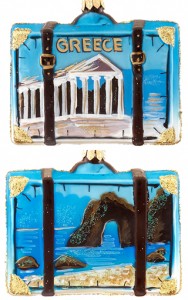Christmas in Greece: Where Symbolism, Tradition and Even Superstition Converge
Posted September 13, 2013 in Christmas Around the World by Dianne Weller

Syntagma Square -Athens: Christmas Tree to celebrate Christmas in Greece
Is it an exotic land filled with exotic Mediterranean people or an earthy domain filled with down-to-earth fishermen?
Is it a country whose people believe in goblin-like spirits hopping through the countryside or who kneel regularly in an Orthodox church?
The answer is “yes,” for the land of Greece is rife with wonderful contradictions and complexities that make it one of the most fascinating stops along Ornamentshop.com’s global tour of Christmas traditions – Christmas in Greece!
Christmas in Greece really begins on December 6, which is St. Nicholas Day. While many European countries mark this important day, Greeks hold it especially dear because St. Nicholas is the patron saint of sailors, and nearly every island family in Greece works in the naval, shipping, fishing or sponge diving industries. The small fishing boats that circle Greece in the Mediterranean and Aegean seas honor St. Nicholas by stringing blue and white lights (the colors of the Greek flag) and placing a likeness of him at the helm.
From the shore, people light candles in chapels and pray to St. Nicholas to protect their loved ones from the dangers of the sea. The Greek Navy also pays tribute to St. Nicholas with a special ceremony at the Hellenic Naval Academy.
Christmas in Greece: A Celebration of Food and Dance
By Christmas Eve, many Greeks are downright famished – and with good reason: they have been fasting since November 15. The end of their 40-day fast is a lively celebration of music and food, often featuring a spit-roast pig, lamb or goat over an open, roaring fire while someone plays the bouzouki.
Stuffed grape leaves, Greek salad, moussaka – an eggplant-based, casserole-style dish – and pita bread often rounds out the meal at many Greek homes to mark Christmas in Greece. For dessert, there is usually christopsomo, which is known as “Christ bread.” These large, sweet loaves are molded into various shapes and the crust is decorated to represent the profession of the – forgive the pun – main breadwinner.
Greeks exchange gifts on January 1, St. Basil’s Day, when another version of the Christ bread, called vasilopsomo, is served. Superstitious Greeks keep an eye on both their gifts and the sweet bread because it would be just like the pesky Kallikantzari to wreak havoc with the bounty if it lay unprotected.
These notorious little troublemakers play pranks on people during the 12 days of Christmas, or from Christmas to the Epiphany, on January 6. Some Greeks say that these mischief-makers look like monkeys; others say they look like wolves. But since these creatures apparently like to slip undetected into homes through chimneys, Greeks try to scare them away by hanging strong herbs near the hearth or burning a fire for 12 straight days.
Christmas in Greece ends as it begins: with a ceremony centered on the water. During the “renewal of waters” (or “blessing of the water”), a priest submerges a crucifix to make the water holy and capable of healing illness and disease.
Share the vibrant story with your friends on Facebook or Twitter – and watch the inner Greek surface in everyone you know.

